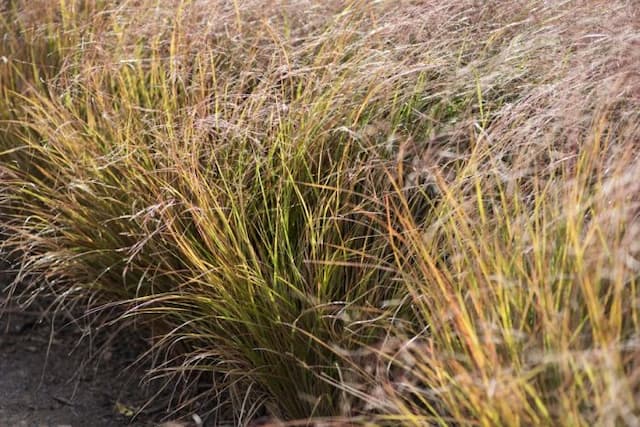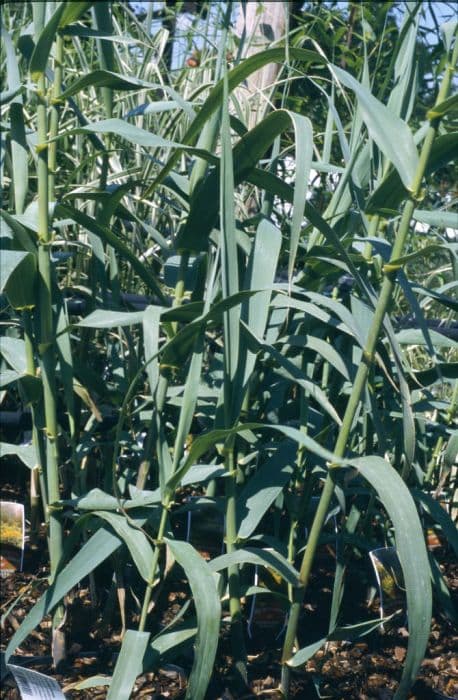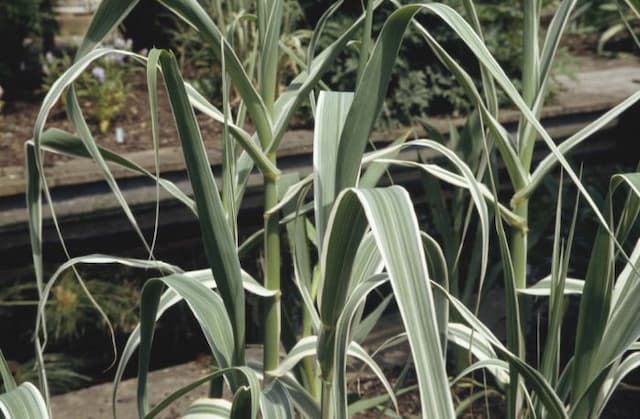Switchgrass Panicum virgatum 'Warrior'











ABOUT
The 'Warrior' is a variant of the switchgrass, which is a perennial grass known for its sturdy and upright form. This particular cultivar showcases slender leaves which exhibit a vibrant green color during the growing season. As the plant matures into the late summer and fall, the foliage often takes on hues of yellow, orange, or red, providing a display of warm colors that enhance its visual interest. The switchgrass 'Warrior' produces fine-textured flower panicles that rise above the foliage in the summer. These flowers can add a soft, airy feel to the plant's appearance. The flowers are initially green or reddish, but as they mature, they transition to a golden brown color, adding to the autumnal charm of this cultivar. In winter, the 'Warrior' switchgrass maintains its structure, with the dried foliage and flower stalks providing a tan or beige color and textural contrast in the landscape. The overall appearance of the 'Warrior' switchgrass is one of resilience and adaptability, conveying a natural and wild aesthetic that can be particularly striking in mass plantings or as a component of a mixed border.
About this plant
 Names
NamesFamily
Poaceae
Synonyms
Switchgrass, Tall Panic Grass, Warrigal Grass, Wild Redtop
Common names
Panicum virgatum.
 Toxicity
ToxicityTo humans
Switchgrass 'Warrior' is not known to be toxic to humans. Ingesting any part of the plant typically does not lead to poisoning or adverse health consequences.
To pets
Switchgrass 'Warrior' is also not considered toxic to pets. Ingestion of this grass should not cause any significant symptoms of poisoning or serious health issues in animals.
 Characteristics
CharacteristicsLife cycle
Perennials
Foliage type
Deciduous
Color of leaves
Green
Flower color
Varies
Height
4-6 feet (1.2-1.8 meters)
Spread
2-3 feet (0.6-0.9 meters)
Plant type
Herb
Hardiness zones
5
Native area
North America
Benefits
 General Benefits
General Benefits- Erosion Control: Panicum virgatum 'Warrior', commonly known as Switchgrass, has a deep root system that stabilizes soil and prevents erosion.
- Drought Tolerance: Once established, it requires little water and can survive in dry conditions, making it an ideal plant for xeriscaping.
- Wildlife Habitat: Provides shelter and food for wildlife, including birds and beneficial insects.
- Low Maintenance: Switchgrass is a low-maintenance plant that does not require frequent fertilization or mowing.
- Adaptability: It can grow in a wide range of soils, from well-drained to clay, and is also tolerant of partial shade.
- Ornamental Value: Offers aesthetic appeal with its upright foliage and airy flower panicles that can add texture and movement to a garden.
- Bioenergy Crop: Utilized as a biomass plant for bioenergy production due to its high yield and rapid growth.
- Carbon Sequestration: Contributes to carbon sequestration as it captures CO2 from the atmosphere and stores it in its extensive root system.
- Natural Fencing: Can be used to create natural barriers or screens for privacy in landscapes and gardens.
- Soil Improvement: Its roots can help break up compacted soil, improving soil structure and promoting the infiltration of water and nutrients.
 Medical Properties
Medical PropertiesThis plant is not used for medical purposes.
 Air-purifying Qualities
Air-purifying QualitiesThis plant is not specifically known for air purifying qualities.
 Other Uses
Other Uses- Panicum virgatum 'Warrior', commonly known as switchgrass, can be used for basket weaving due to its strong and flexible stems.
- Switchgrass can be incorporated into garden paths for its durability and resistance to foot traffic.
- It can serve as a natural dye source, with different parts of the plant producing varying shades for textiles.
- Switchgrass is used in landscaping for erosion control because its root system holds soil effectively.
- This grass is sometimes used in biofilter systems to clean wastewater as it has the ability to absorb excess nutrients and pollutants.
- Switchgrass can be used as a substrate in mushroom cultivation due to its cellulose-rich composition.
- It is utilized in decorative crafts and as a natural filling in homemade dolls or scarecrows.
- In rural areas, switchgrass can be employed as a natural thatching material for roofing due to its long, sturdy stems.
- Switchgrass plays a role in phytoremediation, the process of cleaning up contaminated soil, because of its tolerance to heavy metals and other toxins.
- Artisans may use switchgrass for papermaking, as its fibers provide a unique texture and resilience to handmade papers.
Interesting Facts
 Feng Shui
Feng ShuiThe Switchgrass is not used in Feng Shui practice.
 Zodiac Sign Compitability
Zodiac Sign CompitabilityThe Switchgrass is not used in astrology practice.
 Plant Symbolism
Plant Symbolism- Resilience: Panicum virgatum, known as Switchgrass, often symbolizes resilience as it's a robust plant that thrives in a variety of conditions and can bounce back from environmental stress.
- Adaptability: The 'Warrior' variety of Switchgrass represents adaptability due to its ability to flourish in diverse environments, much like a warrior's ability to endure and adapt to different challenges.
- Endurance: The name 'Warrior' itself suggests endurance and the capability to stand firm, mirroring the hardy nature of the grass which withstands strong winds and weather changes.
- Versatility: Switchgrass is symbolic of versatility, as it is used for ornamental purposes, erosion control, and even biofuel, demonstrating its wide range of applications.
- Sustainability: As a native plant often used in restorative agriculture, Switchgrass embodies the idea of sustainability and environmental stewardship.
- Strength: The robust and upright growth habit of the 'Warrior' cultivar signifies strength, indicating the plant's structural fortitude and ability to support itself and thrive.
 Water
WaterFor the switchgrass 'Warrior', water deeply once a week during dry periods, providing about 1 inch of water each time. Allow the soil to dry out between waterings to encourage deep root growth. During the first growing season, ensure consistent moisture to establish the plant, but once established, switchgrass is quite drought-tolerant and will require less frequent watering. Avoid overhead watering to minimize the risk of leaf diseases. In general, switchgrass prefers regular watering but is adaptable and can tolerate some drought.
 Light
LightSwitchgrass 'Warrior' thrives in full sun conditions, receiving at least 6 hours of direct sunlight daily. It's best placed in an open area where sunlight is abundant throughout the day. This grass can tolerate some light shade, but for optimal growth and flowering, full sun exposure is preferable.
 Temperature
TemperatureSwitchgrass 'Warrior' is hardy and can withstand a wide range of temperatures, making it suitable for many climates. It can survive in temperatures as low as -20°F and as high as 90°F. However, its ideal growing temperatures are between 70°F and 85°F. These conditions promote robust growth and the full development of its feathery, flower panicles.
 Pruning
PruningPrune switchgrass 'Warrior' in late winter or early spring before new growth begins. Cut back the plant to about 4 inches above the ground to remove old growth and make room for new shoots. This annual pruning helps maintain a tidy appearance and promotes healthy, vigorous growth for the upcoming season. Pruning is also the perfect time to divide the plant if necessary.
 Cleaning
CleaningAs needed
 Soil
SoilSwitchgrass 'Warrior' prefers well-draining soil with a pH range of 5.8 to 7.0. A good mix would consist of loam, compost, and sand to ensure proper drainage and fertility. Regular garden soil amended with organic matter can also be beneficial for healthy growth.
 Repotting
RepottingSwitchgrass 'Warrior' is typically an outdoor plant and is not commonly repotted. However, if grown in containers, it may require repotting every 2-3 years to refresh the soil and provide space for growth.
 Humidity & Misting
Humidity & MistingSwitchgrass 'Warrior' is tolerant of a wide range of humidity levels and adapts well to the average outdoor humidity in its growing zones. Indoor humidity is usually not a concern for this species.
 Suitable locations
Suitable locationsIndoor
Place in bright light, cut back in winter; not ideal for indoors.
Outdoor
Full sun, well-drained soil, space 2-3 feet apart.
Hardiness zone
4-9 USDA.
 Life cycle
Life cyclePanicum virgatum 'Warrior', commonly known as Warrior switchgrass, begins its life as a seed sown in the spring, germinating once soil temperatures are consistently warm. Following germination, seedlings will establish a robust root system while developing green, narrow leaves that constitute the early vegetative stage. Growth continues into the summer as the plant reaches the mature vegetative stage, developing tall stems that can reach up to 6 feet and producing a dense foliage clump. By midsummer to early fall, the plant enters the reproductive stage, marked by the emergence of feathery, branched flower panicles that exhibit hues ranging from green to pink or purple. Post pollination, seeds are formed and mature by late fall, ready for dispersal to propagate the next generation. Lastly, after seed set, the plant enters senescence in late fall to winter, with above-ground foliage dying back while the root system remains viable for regrowth the following spring.
 Propogation
PropogationPropogation time
Late Winter-Early Spring
Panicum virgatum 'Warrior', commonly known as Switchgrass, is primarily propagated through division. This is a vegetative method that involves splitting the plant into multiple parts, each with its own root system, to create new plants. The optimal time to propagate Switchgrass by division is in the early spring before new growth begins, or in the late fall once the plant has gone dormant. To divide Switchgrass, dig up the entire clump, being careful to minimize damage to the root system. Use a sharp spade or knife to cut the clump into sections, ensuring each section has a healthy amount of roots and shoots. After dividing, the new plants should be immediately replanted at the same soil depth they were originally growing and watered thoroughly. This method allows for quick establishment and is ideal for expanding garden plantings or producing multiple plants from a single, healthy specimen.









